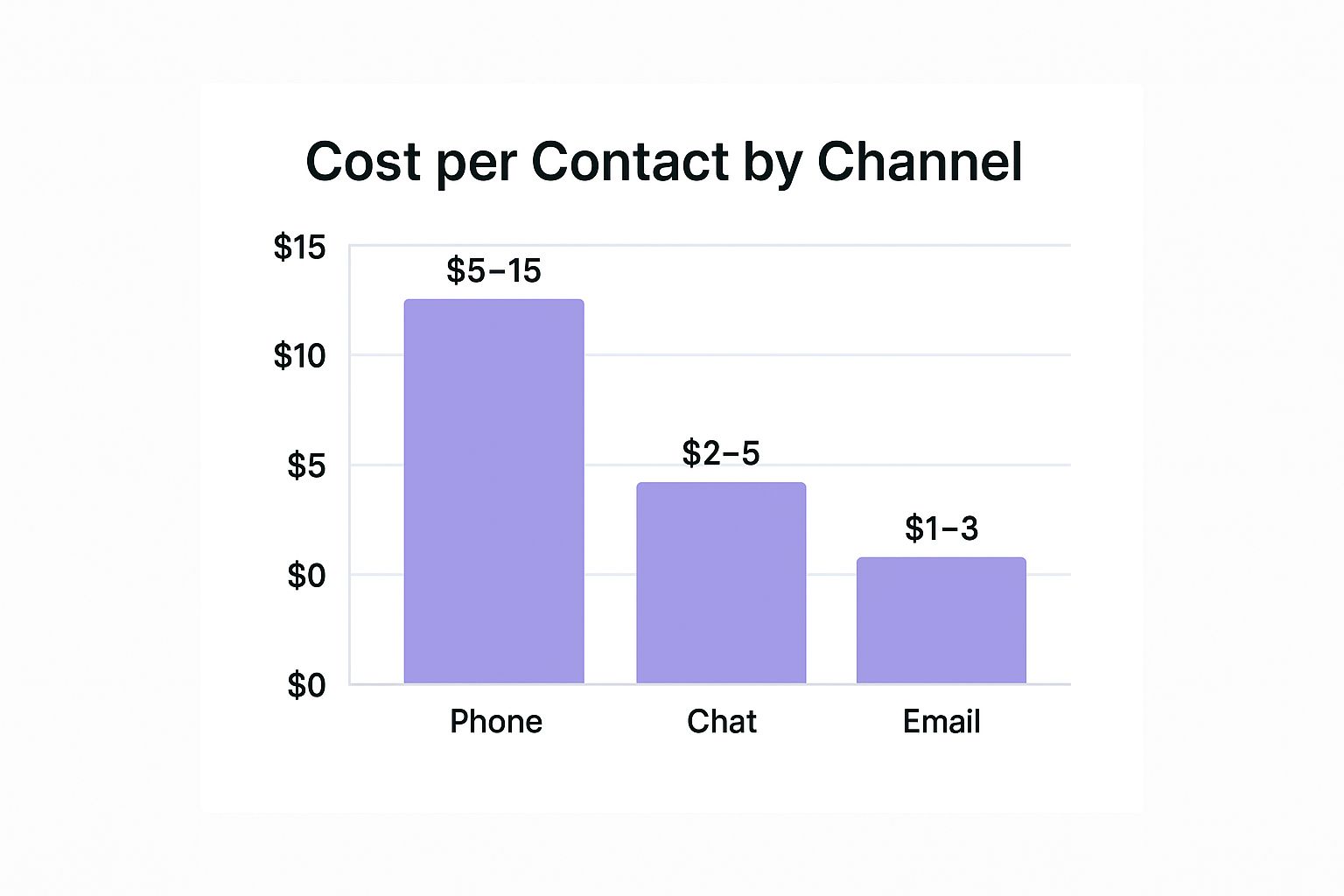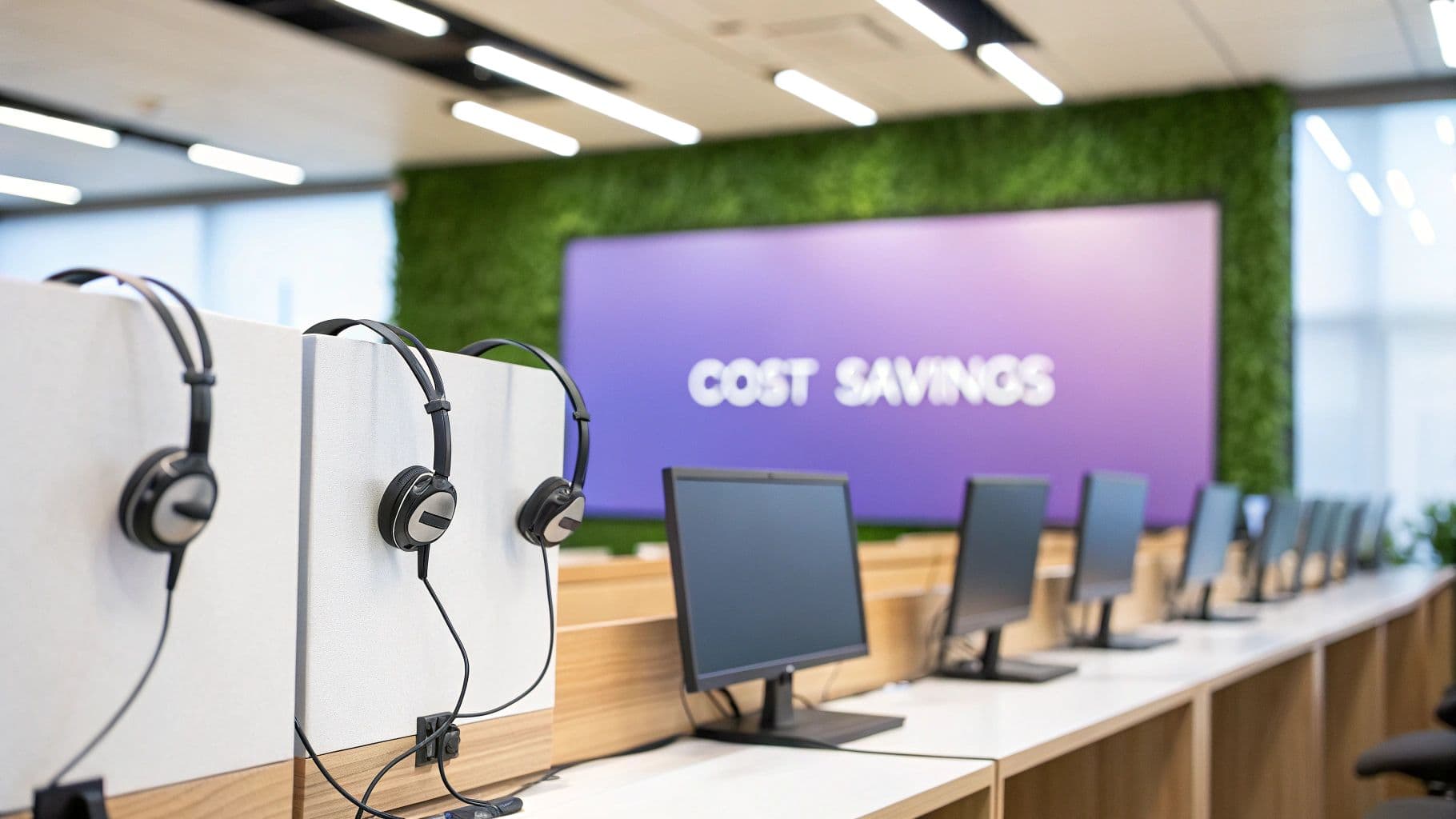Slash Your Call Center Expenses: Smart Strategies for 2025
Want to reduce operational costs without sacrificing customer service? This listicle delivers eight actionable strategies to achieve exactly that. Learn how to optimize your workforce, implement AI-driven solutions, improve first call resolution, and leverage channel optimization to streamline operations and boost efficiency. These tips help businesses of all sizes – from e-commerce retailers to global enterprises – achieve significant cost savings while enhancing customer satisfaction. We'll explore practical approaches to reduce call center costs, including self-service options, strategic outsourcing, and performance incentives.
1. Self-Service Options and Knowledge Bases
One of the most effective strategies to reduce call center costs is empowering customers to resolve their own issues. Implementing comprehensive self-service options, such as knowledge bases, FAQs, and interactive troubleshooting guides, allows customers to find answers and solutions independently, significantly reducing the need for agent intervention. This approach not only minimizes operational costs but also enhances customer satisfaction by providing instant, 24/7 access to information. By shifting simple, repetitive inquiries to self-service channels, you free up your agents to focus on more complex issues and provide personalized support where it's truly needed. This, in turn, optimizes your resources and improves overall efficiency.

Self-service typically involves creating a centralized hub of information, often referred to as a knowledge base, accessible through your website or app. This hub contains a searchable FAQ database, articles covering common issues, interactive troubleshooting guides, and even video tutorials demonstrating specific processes. Modern self-service portals often integrate chatbots and automated phone systems (IVR) that guide customers through a series of questions to pinpoint their problem and direct them to the appropriate resources. This multifaceted approach ensures that customers have multiple avenues to find the information they need quickly and easily, ultimately reducing the volume of calls reaching your agents.
The benefits of robust self-service are substantial. Typically, businesses see a 20-40% reduction in call volume, which directly translates to lower operational costs per customer interaction. Beyond cost savings, self-service enhances customer satisfaction by offering immediate access to information, eliminating wait times, and empowering customers to take control of their own issue resolution. It’s also a highly scalable solution; as your business grows, your self-service portal can easily expand to accommodate new products, services, and customer inquiries.
Companies like Amazon, Microsoft, and Airbnb have successfully leveraged self-service to dramatically reduce support costs and improve customer experience. Amazon's comprehensive help center, for example, has been credited with a 35% reduction in support tickets. Microsoft's automated troubleshooting tools handle 60% of technical issues, freeing up their support staff for more complex problems. Airbnb's self-service platform resolves 70% of booking inquiries, enabling them to efficiently manage a large volume of customer interactions. Even companies like Zappos, known for their exceptional customer service, utilize detailed FAQ systems to handle common questions about sizing and returns, demonstrating the broad applicability of this approach.
While self-service offers numerous advantages, it's essential to be aware of the potential drawbacks. Initial development and setup costs can be significant, requiring investment in software, content creation, and integration with existing systems. Ongoing maintenance and content updates are crucial to ensure accuracy and relevance, adding to the long-term cost. Complex issues may still require agent assistance, and poorly designed self-service portals can frustrate customers if they can't easily find the information they need or escalate their issue to a live agent. For certain demographics, particularly those less tech-savvy, self-service may not be the preferred method of support.
To maximize the effectiveness of your self-service strategy, start by analyzing your most common call reasons. This data will inform the prioritization of your content creation efforts, ensuring you address the most pressing customer needs first. Use clear, concise, and non-technical language in your help articles and FAQs. Implement robust search functionality with autocomplete suggestions to help customers quickly locate relevant information. Regularly update your content to reflect new products, services, and policy changes. Critically, provide easy escalation paths to live support when self-service fails to resolve the issue. Finally, track key metrics like deflection rate (the percentage of calls diverted to self-service) and customer satisfaction to measure the success of your implementation and identify areas for improvement. Learn more about Self-Service Options and Knowledge Bases By implementing these strategies, you can leverage self-service options to significantly reduce call center costs while empowering your customers and enhancing their overall experience.
2. Workforce Optimization and Agent Scheduling
One of the most significant expenses for any call center is labor. Optimizing your workforce and implementing strategic agent scheduling is a powerful way to reduce call center costs without sacrificing service quality. This approach leverages advanced analytics and forecasting tools to ensure you have the right number of agents with the right skills available at the right time. Instead of relying on guesswork or static schedules, workforce optimization dynamically adjusts staffing levels to match real-time demand, minimizing overstaffing during slow periods and preventing understaffing during peak times. This translates directly into cost savings and improved customer experience.

Workforce optimization goes beyond simply creating schedules. It involves a comprehensive strategy that includes several key components: predictive analytics for accurate call volume forecasting, skills-based routing to connect customers with the most qualified agents, flexible scheduling models incorporating part-time and remote work options, and real-time schedule adjustments based on actual call patterns. Cross-training programs are also crucial, enabling agents to handle a wider range of inquiries and further optimizing resource allocation. By analyzing historical data, identifying peak and off-peak hours, and understanding customer behavior, you can create highly efficient schedules that minimize downtime and maximize agent utilization. Performance-based scheduling optimization further refines this process by incorporating agent performance metrics into scheduling decisions, ensuring top performers are strategically positioned during critical periods.
This approach has proven successful for businesses of all sizes. Delta Airlines, for instance, achieved a 20% reduction in staffing costs by implementing predictive scheduling. Similarly, American Express optimized its global workforce deployment, saving $12 million annually. T-Mobile saw an 18% improvement in efficiency thanks to flexible scheduling, while Capital One boosted first-call resolution by 25% through skills-based routing. These real-world examples demonstrate the significant impact workforce optimization can have on both cost reduction and service improvement.
So, when should you consider implementing this approach? Workforce optimization is particularly beneficial for organizations experiencing fluctuating call volumes, those struggling with high overtime costs, or companies looking to improve agent satisfaction and reduce attrition. Businesses aiming to enhance customer experience by reducing wait times and ensuring faster resolution will also find significant value in this strategy. This makes it ideal for small and medium-sized businesses seeking scalable, 24/7 customer support, e-commerce retailers needing to optimize order management and response times, and global enterprises requiring multilingual, round-the-clock customer engagement.
Here are some actionable tips to effectively implement workforce optimization and agent scheduling:
- Analyze historical data: Identify peak and low-demand periods to accurately forecast future call volumes. This forms the foundation of effective scheduling.
- Implement skills-based routing: Maximize agent utilization by connecting customers with agents who possess the specific skills needed to address their inquiries.
- Use real-time dashboards: Monitor call patterns and make dynamic schedule adjustments to respond effectively to unexpected fluctuations in demand.
- Offer flexible work arrangements: Attract and retain talent by offering part-time and remote work options, enhancing agent satisfaction and flexibility.
- Cross-train agents: Equip agents to handle multiple inquiry types, improving efficiency and reducing the need for specialized agents for every customer interaction.
- Monitor adherence to schedule: Track how well agents adhere to their schedules and regularly adjust forecasting models to maintain accuracy and optimize staffing levels.
While the benefits are substantial, it’s important to be aware of the potential drawbacks. Implementing workforce optimization requires sophisticated forecasting tools and expertise. It can also introduce scheduling complexity for managers and may encounter resistance from agents accustomed to traditional scheduling practices. There is an initial investment in workforce management software, and if forecasts are inaccurate, there is a risk of understaffing. However, with careful planning, effective communication, and the right tools, these challenges can be mitigated. Ultimately, the potential cost savings of 15-25% through optimized staffing, coupled with improved service levels and increased agent satisfaction, make workforce optimization a crucial strategy for any call center looking to thrive in today's competitive landscape.
3. Offshore and Nearshore Outsourcing
One of the most effective strategies to reduce call center costs is offshore and nearshore outsourcing. This involves strategically relocating your call center operations to countries with lower labor costs while maintaining, and sometimes even improving, service quality. This approach allows businesses to leverage significant cost arbitrage opportunities without compromising customer experience. Offshore outsourcing typically refers to partnering with providers in distant countries like India or the Philippines, while nearshore outsourcing focuses on nearby countries, often with similar time zones, such as Mexico or Costa Rica for North American businesses. This strategy deserves its place on this list because it offers a powerful combination of cost savings and scalability, enabling businesses to optimize their support operations and focus on core competencies.
How Offshore and Nearshore Outsourcing Works
The process typically begins with identifying specific call center functions that can be outsourced. This might include customer service, technical support, order processing, or back-office tasks. Businesses then select a suitable outsourcing provider based on factors like experience, expertise, language capabilities, and security certifications. Clear service level agreements (SLAs) are established to define performance expectations and ensure accountability. The outsourcing provider then recruits and trains agents, sets up the necessary infrastructure, and manages the day-to-day operations of the outsourced call center.
Features and Benefits
Offshore and nearshore outsourcing offer a range of compelling features:
- Access to a Skilled Multilingual Workforce: Many offshore and nearshore locations boast large pools of educated, multilingual professionals, making it easier to provide support in various languages.
- Significant Labor Cost Arbitrage: This is the primary driver for many businesses. Labor costs in offshore locations can be significantly lower (40-60% less) than in developed countries.
- 24/7 Operations Across Multiple Time Zones: Outsourcing allows businesses to offer round-the-clock support without incurring expensive night shift premiums.
- Scalable Capacity Without Infrastructure Investment: Providers handle the infrastructure, allowing businesses to easily scale up or down based on demand fluctuations.
- Cultural and Language Compatibility Options: Nearshore locations can offer greater cultural and language alignment with certain customer bases.
These features translate into tangible benefits like labor cost savings, improved customer satisfaction through extended support hours, increased operational efficiency, and the ability to focus internal resources on strategic initiatives.
Examples of Successful Implementation
Numerous companies have successfully implemented offshore and nearshore outsourcing strategies to reduce call center costs:
- IBM: Reportedly saved $3 billion annually through a global outsourcing strategy that included call center operations.
- General Electric: Reduced support costs by 45% by leveraging call centers in India.
- American Express: Successfully operates multiple call centers in India and the Philippines.
- AT&T: Utilizes nearshore centers in Mexico to cater to its Spanish-speaking customer base.
These examples demonstrate the potential of offshore and nearshore outsourcing to achieve significant cost reductions while maintaining or improving service quality.
Pros and Cons
While the benefits are compelling, it’s important to consider the potential downsides:
Pros:
- Substantial labor cost savings.
- Access to a large, skilled talent pool.
- 24/7 support coverage.
- Scalability and flexibility.
- Focus on core business functions.
Cons:
- Potential language and cultural barriers.
- Time zone coordination challenges.
- Quality control and training oversight.
- Potential customer preference for domestic support.
- Data security and compliance concerns.
- Possible negative brand perception if not managed effectively.
When and Why to Use This Approach
Offshore and nearshore outsourcing is particularly well-suited for businesses experiencing rapid growth, dealing with high call volumes, needing multilingual support, or seeking to significantly reduce operating expenses. E-commerce retailers, global enterprises, and businesses with seasonal demand fluctuations can benefit greatly from this approach. Small and medium-sized businesses can also leverage outsourcing to access enterprise-level support capabilities without significant upfront investment.
Actionable Tips for Successful Outsourcing
- Start Small: Begin by outsourcing non-critical functions to test the provider's capabilities.
- Establish Clear SLAs: Define specific metrics and penalties for non-compliance.
- Invest in Training: Ensure proper cultural training and accent neutralization for agents.
- Data Security: Implement robust data security and compliance protocols.
- Maintain Domestic Capacity: Keep some domestic agents for escalations and VIP customers.
- Choose Stable Locations: Opt for locations with political stability and strong telecommunications infrastructure.
By carefully considering the pros and cons and implementing the tips outlined above, businesses can successfully leverage offshore and nearshore outsourcing to reduce call center costs while maintaining a high level of customer service.
4. Artificial Intelligence and Automation
One of the most impactful ways to reduce call center costs is through the strategic implementation of artificial intelligence (AI) and automation. This involves deploying AI-powered solutions like chatbots, virtual assistants, and automated workflows to handle routine customer inquiries and processes, minimizing the need for human intervention. These technologies leverage natural language processing (NLP), machine learning (ML), and robotic process automation (RPA) to resolve customer issues, update records, and perform administrative tasks automatically, freeing up human agents to focus on more complex and nuanced interactions.

AI-driven solutions analyze incoming customer communications, understand the intent behind them, and provide relevant responses or initiate appropriate actions. For instance, a chatbot can guide a customer through troubleshooting steps for a common technical issue or a virtual assistant can process a refund request. Machine learning algorithms allow these systems to learn from each interaction, continuously improving their accuracy and efficiency over time. Integration with CRM and backend systems enables seamless data exchange and updates, further streamlining processes and enhancing the customer experience. Features like sentiment analysis can also detect frustration in customer communications, triggering escalation to a human agent when necessary. This blended approach ensures that while automation handles the bulk of routine tasks, human empathy and expertise are available for more sensitive situations.
The benefits of AI and automation in call centers are substantial. These solutions can handle an unlimited number of simultaneous interactions, operate 24/7 without breaks, and deliver consistent service quality and response accuracy. Immediate response times contribute significantly to improved customer satisfaction. While there's an initial investment involved in development and implementation, the long-term cost savings are significant due to reduced labor costs and increased efficiency. By automating repetitive tasks, AI frees human agents to focus on complex, high-value interactions requiring empathy, creativity, and critical thinking, leading to improved employee satisfaction and retention.
Several companies have successfully implemented AI and automation to reduce call center costs and enhance customer service. Bank of America's virtual assistant, Erica, handles over 1 billion customer requests annually. Domino's chatbot automates 65% of customer orders, streamlining the ordering process and freeing up staff. H&M’s virtual assistant has reduced customer service costs by a remarkable 70%, demonstrating the potential for significant cost reduction. Similarly, KLM uses AI to manage over 15,000 social media interactions weekly, efficiently addressing customer queries and concerns across multiple channels.
While the benefits are compelling, there are also challenges associated with implementing AI and automation. The initial development and implementation costs can be high. AI-powered systems are currently limited in their ability to handle highly complex or emotionally charged situations, requiring careful planning and design of escalation paths to human agents. Ongoing training and algorithm updates are essential to maintain accuracy and relevance. Furthermore, poorly designed automated responses can lead to customer frustration. Integrating AI with legacy systems can also present technical challenges. Finally, job displacement concerns for human agents need to be addressed through reskilling and redeployment strategies.
To effectively leverage AI and automation in your call center, consider these tips: Start with simple, high-volume inquiries before tackling more complex scenarios. Provide clear and easily accessible escalation paths to human agents when needed. Continuously train your AI models with new data and scenarios to ensure they remain accurate and effective. Monitor customer satisfaction metrics for automated interactions to identify areas for improvement. Design conversational flows that feel natural and helpful to customers. And finally, test your AI-powered solutions extensively before full deployment to avoid negative customer experiences. Learn more about Artificial Intelligence and Automation and read the Intercom chatbot pricing guide
This approach is particularly well-suited for small and medium-sized businesses seeking scalable, 24/7 customer support, e-commerce retailers aiming to improve order management and response times, customer service teams looking to automate repetitive inquiries and reduce costs, digital agencies offering AI-driven support solutions to their clients, and global enterprises requiring multilingual, round-the-clock customer engagement. By strategically implementing AI and automation, businesses can significantly reduce call center costs, enhance customer satisfaction, and empower their human agents to deliver higher-value service.
5. Channel Optimization and Digital Deflection
One of the most effective strategies to reduce call center costs is channel optimization and digital deflection. This approach focuses on strategically guiding customers towards lower-cost communication channels, such as email, chat, social media, and mobile apps, while maintaining a high level of service quality. By reducing reliance on expensive phone support, businesses can significantly cut operational expenses without sacrificing customer satisfaction. This is achieved through intelligent channel routing, proactive customer education, and a seamless multi-channel customer service platform.
This method works by presenting customers with a variety of communication options and subtly encouraging the use of digital self-service tools and lower-cost channels. For instance, a well-placed link to a comprehensive FAQ section or a prominent chat widget on your website can effectively divert customers away from the phone. Intelligent routing systems further optimize this process by analyzing incoming inquiries and directing them to the most appropriate channel based on their type and complexity. Simple queries can be handled efficiently through chatbots or self-service portals, while complex issues are escalated to human agents via phone or email.
The benefits of channel optimization and digital deflection are numerous. As illustrated below, phone calls can cost anywhere from $5 to $15 per interaction, while chat interactions average between $2 and $5, and email even less at $1 to $3. This difference in cost per contact can translate to significant savings, especially for businesses with high call volumes. Beyond cost reduction, digital channels also offer improved customer convenience, better documentation of interactions, and the ability for agents to handle multiple inquiries simultaneously. Enhanced analytics and performance measurement capabilities further enable businesses to continuously optimize their channel strategy. As more communication shifts to digital channels, it's crucial to optimize your channels to reduce call volume. This includes leveraging business text messaging solutions for customer service and other key touchpoints.
Several companies have successfully implemented this strategy. Spotify, for example, shifted 60% of its support interactions from phone to chat, saving $2 million annually. Netflix took a more radical approach, eliminating phone support entirely and focusing on chat and self-service. Adobe reduced phone volume by 40% through proactive chat promotion, and Shopify's robust help center now deflects 80% of potential phone calls.
The following bar chart visualizes the average cost per contact across three common customer service channels: phone, chat, and email.

As the chart clearly demonstrates, phone support remains the most expensive channel, while email and chat offer significant cost advantages.
While the advantages are clear, businesses should also consider the potential challenges. Customer resistance to changing communication preferences can be a hurdle. Managing quality standards across multiple channels adds complexity, and there's an initial investment required for digital channel infrastructure. Finally, businesses need to carefully manage the customer experience to avoid fragmentation across different channels. Adequate agent training across multiple platforms is crucial for success.
To effectively implement channel optimization and digital deflection, consider these tips: Analyze the cost per contact for each channel and actively promote lower-cost options. Offer incentives for customers to use preferred channels and ensure consistent service quality across all touchpoints. Use proactive messaging to guide customers to the appropriate channels, and train agents to be proficient in multiple digital communication methods. Continuously track channel migration success and customer satisfaction to fine-tune your strategy.
Channel optimization and digital deflection deserves a prominent place in any cost-reduction strategy because it addresses the core driver of call center expense: high phone call volume. By leveraging lower-cost digital channels, businesses can significantly reduce expenses while simultaneously improving customer convenience and satisfaction. Learn more about Channel Optimization and Digital Deflection. This approach is particularly beneficial for businesses experiencing high call volumes, those seeking to enhance customer experience through increased channel choice, and companies looking to improve the efficiency of their customer service operations. By integrating a multi-channel customer service platform, implementing intelligent routing, and prioritizing customer preference tracking, businesses can unlock the full potential of digital deflection and significantly reduce call center costs.
6. First Call Resolution (FCR) Improvement
One of the most impactful strategies to reduce call center costs is prioritizing First Call Resolution (FCR). This systematic approach aims to resolve customer issues completely during the initial contact, eliminating the need for follow-up calls, reducing overall operational costs, and boosting customer satisfaction. By empowering agents with the necessary tools, training, and information to handle inquiries effectively from the start, businesses can significantly improve efficiency and minimize expenses associated with repeated interactions. This makes FCR a critical component of any cost-reduction strategy for call centers.
FCR works by equipping agents to handle a wide range of customer issues effectively and efficiently. This involves several key elements: comprehensive training on products, services, and internal processes; access to integrated knowledge management systems containing up-to-date information and solutions; advanced CRM systems providing a complete customer history for personalized service; clear escalation procedures and ready access to specialists for complex issues; and ongoing quality monitoring and coaching programs to reinforce best practices and identify areas for improvement. By addressing these areas, businesses create an environment where agents are well-equipped to resolve inquiries on the first contact.
The benefits of a successful FCR strategy are numerous. Firstly, it drastically reduces total call volume, leading to significant cost savings in staffing, infrastructure, and operational expenses. Secondly, it dramatically improves customer satisfaction by minimizing customer effort and frustration associated with multiple calls and extended resolution times. This positive experience translates into increased customer loyalty and positive word-of-mouth referrals. Thirdly, higher FCR rates boost agent confidence and job satisfaction by empowering them to provide effective solutions and reducing the stress of handling repeat calls. Finally, it improves overall operational efficiency by streamlining workflows and freeing up agents to handle more inquiries.
Several companies have demonstrated the impressive ROI of implementing FCR programs. Southwest Airlines achieved an 87% FCR rate, reducing repeat calls by a remarkable 45%. FedEx improved its FCR from 74% to 89%, saving $15 million annually. Verizon's FCR program reduced call volume by 25%, and Progressive Insurance's 85% FCR rate significantly improved customer satisfaction scores. These examples highlight the potential of FCR to transform call center operations and significantly reduce costs.
However, implementing an effective FCR strategy isn't without its challenges. Initially, it can lead to longer average handle times per call as agents take the time to fully understand and resolve issues comprehensively. It also requires a significant investment in agent training, knowledge management systems, and potentially system upgrades for better integration. There’s also the potential for agents to rush complex issues in an effort to meet FCR targets, which can negatively impact resolution quality. Therefore, ongoing coaching and quality management are essential to ensure that FCR goals are balanced with providing excellent customer service.
For small and medium-sized businesses seeking scalable, 24/7 customer support, e-commerce retailers aiming to improve order management and response times, customer service teams looking to automate repetitive inquiries and reduce costs, digital agencies offering AI-driven support solutions, and global enterprises requiring multilingual, round-the-clock customer engagement, investing in FCR can be a game-changer. By implementing the following tips, businesses can maximize their FCR success:
- Measure and track FCR rates consistently across all agents. This provides valuable data to identify trends, areas for improvement, and agent performance.
- Provide agents with comprehensive product and policy training. Equip them with the knowledge they need to handle a wide range of customer inquiries effectively.
- Ensure agents have access to complete customer history through integrated CRM systems. This allows for personalized service and efficient issue resolution.
- Implement quality monitoring programs focused on resolution completeness. Regularly review calls to identify areas where agents can improve their FCR performance.
- Analyze reasons for repeat calls and address root causes. This proactive approach helps prevent future similar issues and improves overall FCR rates.
- Balance FCR goals with handle time to avoid rushed resolutions. Focus on quality resolutions rather than simply aiming for the quickest solution.
By focusing on FCR, businesses can significantly reduce call center costs, improve customer satisfaction, and create a more efficient and effective operation. While it requires an initial investment, the long-term benefits make it a crucial strategy for any call center aiming to optimize its performance and reduce expenses.
7. Performance-Based Compensation and Incentives
One of the most effective strategies to reduce call center costs while simultaneously boosting agent performance and customer satisfaction is implementing a performance-based compensation and incentive program. This approach moves away from a flat salary model and strategically aligns agent pay with key performance indicators (KPIs) that directly impact both cost reduction and service quality. This helps ensure your team is focused on the right goals, contributing to a more efficient and cost-effective operation. This method is particularly impactful for businesses focused on minimizing expenses while maintaining high service standards, making it a valuable addition to this list.
Essentially, performance-based compensation involves a base salary supplemented by variable compensation tied to specific metrics. These metrics might include customer satisfaction (CSAT) scores, first call resolution (FCR) rates, average handling time (AHT), productivity measures (e.g., calls handled per hour), and cost-per-contact achievements. By rewarding agents for achieving and exceeding targets related to these metrics, you directly motivate the behaviors that contribute to a leaner, more effective call center and help reduce call center costs.
A well-structured performance-based compensation plan includes several key features:
- Multi-metric Scorecard: Avoid focusing on just one metric. A balanced scorecard incorporates both quality (e.g., CSAT, FCR) and efficiency (e.g., AHT, cost-per-contact) measures to ensure a holistic approach to performance.
- Tiered Incentive Structure: Implement a system where higher performance levels unlock progressively greater rewards. This encourages agents to strive for continuous improvement.
- Team-Based Bonuses: While individual incentives are important, team-based bonuses foster collaboration and shared responsibility for overall performance. This can significantly improve morale and reduce call center costs.
- Recognition Programs: Acknowledge and celebrate top performers through regular recognition programs. This can be as simple as a public acknowledgment or as substantial as a bonus or award.
- Career Advancement Tied to Performance: Create a clear path for career progression based on performance metrics. This motivates agents to invest in their skills and contribute to long-term success, ultimately helping to reduce call center costs through improved efficiency and retention.
- Regular Feedback and Coaching Sessions: Provide consistent feedback and coaching to help agents understand their performance and identify areas for improvement. This support is essential for maximizing the effectiveness of any incentive program.
Several real-world examples demonstrate the positive impact of performance-based compensation:
- Teleperformance: Quality-based incentives improved customer satisfaction by 22%.
- Convergys: Team-based bonuses contributed to a 15% reduction in attrition, reducing the costs associated with hiring and training.
- SYKES: A comprehensive performance program increased agent productivity by 18%, leading to significant cost savings.
- Concentrix: A multi-tier incentive system improved FCR by 12%, reducing the need for repeat calls and lowering operational costs.
While the benefits are substantial, it’s crucial to be aware of potential drawbacks and implement the program carefully. A poorly designed system can encourage "gaming" of the metrics, create unhealthy competition among team members, and even increase overall compensation costs if not managed effectively. Sophisticated tracking and measurement systems are also necessary to monitor performance accurately.
To maximize the effectiveness of a performance-based compensation program and reduce call center costs, consider these tips:
- Balance Multiple Metrics: Avoid overemphasizing any single metric to prevent agents from focusing on one area while neglecting others.
- Include Both Individual and Team-Based Incentives: This fosters both individual motivation and collaborative spirit.
- Set Achievable but Challenging Performance Targets: Targets should stretch agents' capabilities without being demotivating.
- Provide Real-Time Dashboards for Performance Tracking: Transparency and readily available data empowers agents to monitor their progress and make adjustments.
- Regularly Review and Adjust Incentive Structures: Market conditions and business objectives change, so your incentive program should adapt accordingly.
- Ensure Incentives Align with Overall Business Objectives: The program should drive behaviors that directly contribute to the company's strategic goals, including reducing call center costs.
By implementing a well-designed performance-based compensation program and adhering to these best practices, businesses can effectively motivate their call center agents, improve key performance indicators, enhance customer satisfaction, and ultimately reduce call center costs.
8. Technology Integration and Process Automation: Slashing Call Center Costs Through Efficiency
In today's fast-paced business environment, customers expect quick, efficient, and personalized service. Meeting these expectations while keeping costs under control is a major challenge for call centers. Technology integration and process automation offer a powerful solution to reduce call center costs by streamlining operations, boosting agent efficiency, and improving the overall customer experience. This approach deserves its place on this list due to its potential to significantly impact both the top and bottom line of your business.
Technology integration involves connecting various systems within the call center, including CRM software, automatic call distributors (ACDs), and back-office databases. This creates a unified ecosystem where information flows seamlessly between different platforms. Process automation, in conjunction with technology integration, allows routine tasks to be handled automatically, freeing up agents to focus on more complex issues and providing personalized support.
How it Works:
Imagine a customer calls your call center. With integrated systems, the ACD routes the call to the most appropriate agent based on their skills and availability. Simultaneously, screen pop technology displays the customer's information, pulled from the integrated CRM, even before the agent answers the call. This information might include past purchase history, current order status, previous interactions, and preferred communication channels. Armed with this knowledge, the agent can personalize the interaction and resolve issues faster. Furthermore, workflow automation can handle tasks like order tracking updates, appointment scheduling, and basic troubleshooting automatically through interactive voice response (IVR) systems or chatbots, further reducing the burden on human agents.
Features and Benefits:
- Unified Customer Database with 360-Degree View: Provides agents with a complete picture of the customer's interactions, preferences, and history, enabling personalized service and faster issue resolution.
- Automatic Call Distribution (ACD) with Skills-Based Routing: Directs calls to the most qualified agent, reducing wait times and improving first call resolution rates.
- Screen Pop Technology: Presents relevant customer information to agents before they answer the call, eliminating the need for manual data lookup and reducing handle time.
- Workflow Automation: Automates routine processes like order updates, appointment scheduling, and basic troubleshooting, freeing up agent time for more complex issues.
- Real-Time Analytics and Reporting Dashboards: Provides insights into call center performance, enabling data-driven decision-making and continuous improvement.
- Integration with Back-Office Systems and Databases: Streamlines information flow between different departments, ensuring data consistency and reducing manual data entry.
Examples of Successful Implementation:
Several companies have successfully implemented technology integration and process automation to reduce call center costs and improve customer service. Salesforce Service Cloud integration has helped clients reduce handle time by as much as 30%. Genesys' omnichannel platform helped T-Mobile improve efficiency by 25%, while Zendesk implementation at Shopify reduced resolution time by a significant 40%. These examples showcase the potential for significant cost savings and service enhancements.
Pros and Cons:
Pros:
- Reduced average handle time through faster information access.
- Improved first call resolution with complete customer context.
- Elimination of manual data entry and reduced errors.
- Enabled better workforce management through analytics.
- Consistent customer experience across all touchpoints.
Cons:
- Significant upfront investment in technology and integration.
- Complexity in integrating multiple legacy systems.
- Requires extensive agent training on new systems.
- Potential system downtime affecting operations.
- Ongoing maintenance and upgrade costs.
Actionable Tips for Implementation:
- Thorough Needs Assessment: Before investing in any technology, conduct a comprehensive needs assessment to determine the specific requirements of your call center.
- Phased Implementation: Implement the new systems gradually rather than all at once to minimize disruption and allow for adjustments.
- Extensive Testing: Plan for rigorous testing of the integrated systems before going live to ensure seamless operation and identify potential issues.
- Comprehensive Training: Provide thorough training and ongoing support to agents to ensure they are comfortable using the new technologies.
- Performance Monitoring: Monitor key performance indicators (KPIs) closely during and after implementation to measure the effectiveness of the changes.
- Disaster Recovery Plan: Ensure robust backup and disaster recovery procedures are in place to minimize the impact of potential system downtime.
When and Why to Use this Approach:
Technology integration and process automation are particularly beneficial for:
- Small and medium-sized businesses seeking scalable, 24/7 customer support.
- E-commerce retailers aiming to improve order management and response times.
- Customer service teams looking to automate repetitive inquiries and reduce costs.
- Digital agencies offering AI-driven support solutions to their clients.
- Global enterprises requiring multilingual, round-the-clock customer engagement.
By strategically integrating technology and automating processes, call centers can significantly reduce costs, improve efficiency, and deliver a superior customer experience. This proactive approach not only addresses present challenges but also positions businesses for future growth and success in the competitive customer service landscape.
Cost Reduction Strategies Comparison
| Strategy | Implementation Complexity 🔄 | Resource Requirements ⚡ | Expected Outcomes 📊 | Ideal Use Cases 💡 | Key Advantages ⭐ |
|---|---|---|---|---|---|
| Self-Service Options and Knowledge Bases | High initial setup; ongoing maintenance required | Medium; content creation, platform integration | Reduce call volume by 20-40%, lower costs | Businesses aiming to deflect common queries and scale support | 24/7 availability, cost savings, scalable |
| Workforce Optimization and Agent Scheduling | Requires advanced analytics and scheduling tools | High; analytics software, skilled management | Reduce labor costs 15-25%, improve service levels | Organizations with fluctuating demand and large agent pools | Cost-effective staffing, improved agent satisfaction |
| Offshore and Nearshore Outsourcing | Medium to high; legal and compliance considerations | High; vendor management, cross-cultural training | Labor cost savings 40-60%, scalable capacity | Companies seeking cost reduction with 24/7 global coverage | Significant cost savings, multilingual talent |
| Artificial Intelligence and Automation | High development and integration complexity | High; AI specialists, training data, infrastructure | 50-80% cost reduction, 24/7 unlimited interactions | Handling high volume routine inquiries, improving response speed | Consistent quality, frees agents for complex tasks |
| Channel Optimization and Digital Deflection | Medium; multi-channel platform deployment | Medium; digital tools, agent training | Lower contact costs, improved customer convenience | Businesses shifting customers to digital channels | Cost reduction, better analytics, customer choice |
| First Call Resolution (FCR) Improvement | Medium; requires training and system upgrades | Medium; agent training, quality monitoring tools | Reduces repeat calls, improves satisfaction | Customer-centric organizations focused on quality | Higher satisfaction, fewer repeat contacts |
| Performance-Based Compensation and Incentives | Medium; design and monitoring of incentive systems | Medium; HR resources, performance tracking tools | Motivated agents, reduced turnover, improved KPIs | Contact centers aiming to align pay with performance | Drives quality and efficiency, rewards top agents |
| Technology Integration and Process Automation | High; involves complex system integration | High; technology investment, training | 20-40% operational efficiency improvement | Organizations needing unified systems to streamline operations | Faster handle times, error reduction, analytics |
Taking Action: Implement These Strategies and Reap the Rewards
Reducing call center costs is a continuous journey, not a destination. This article has explored eight key strategies to help you navigate that journey effectively: from empowering customers with self-service options and optimizing workforce management, to leveraging the power of AI and automation and improving first call resolution. By embracing these strategies, you can streamline operations, boost agent performance, and elevate customer satisfaction – all while significantly reducing your call center costs. The most impactful changes often come from a holistic approach. Consider how these strategies can work together to create a synergistic effect, further amplifying your cost savings and improving overall efficiency. Mastering these concepts isn't just about cutting costs; it's about building a more resilient, adaptable, and customer-centric call center operation, ultimately driving sustainable growth and enhancing profitability. Remember that evaluating your existing setup and identifying areas for improvement is the crucial first step towards achieving these goals.
For businesses looking to seamlessly integrate these cost-saving measures, explore FlowGent AI. This platform offers comprehensive solutions designed to automate processes, optimize workforce management, and deliver exceptional customer experiences at a lower cost, directly addressing the core challenges of reducing call center costs. Ready to transform your call center and unlock significant savings? Visit FlowGent AI today to learn more.



